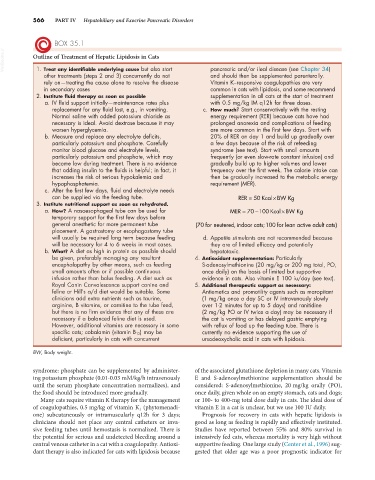Page 594 - Small Animal Internal Medicine, 6th Edition
P. 594
566 PART IV Hepatobiliary and Exocrine Pancreatic Disorders
BOX 35.1
VetBooks.ir Outline of Treatment of Hepatic Lipidosis in Cats
1. Treat any identifiable underlying cause but also start
and should then be supplemented parenterally.
other treatments (steps 2 and 3) concurrently do not pancreatic and/or ileal disease (see Chapter 34)
rely on—treating the cause alone to resolve the disease Vitamin K–responsive coagulopathies are very
in secondary cases common in cats with lipidosis, and some recommend
2. Institute fluid therapy as soon as possible supplementation in all cats at the start of treatment
a. IV fluid support initially—maintenance rates plus with 0.5 mg/kg IM q12h for three doses.
replacement for any fluid lost, e.g., in vomiting. c. How much? Start conservatively with the resting
Normal saline with added potassium chloride as energy requirement (RER) because cats have had
necessary is ideal. Avoid dextrose because it may prolonged anorexia and complications of feeding
worsen hyperglycemia. are more common in the first few days. Start with
b. Measure and replace any electrolyte deficits, 20% of RER on day 1 and build up gradually over
particularly potassium and phosphate. Carefully a few days because of the risk of refeeding
monitor blood glucose and electrolyte levels, syndrome (see text). Start with small amounts
particularly potassium and phosphate, which may frequently (or even slow-rate constant infusion) and
become low during treatment. There is no evidence gradually build up to higher volumes and lower
that adding insulin to the fluids is helpful; in fact, it frequency over the first week. The calorie intake can
increases the risk of serious hypokalemia and then be gradually increased to the metabolic energy
hypophosphatemia. requirement (MER).
c. After the first few days, fluid and electrolyte needs
can be supplied via the feeding tube. RER = 50 KcalBW Kg
×
3. Institute nutritional support as soon as rehydrated.
a. How? A nasoesophageal tube can be used for MER = 70 100 KcalBW Kg
×
−
temporary support for the first few days before
general anesthetic for more permanent tube (70 for neutered indoor cats ;100 for lean active adult cats )
,
placement. A gastrostomy or esophagostomy tube
will usually be required long term because feeding d. Appetite stimulants are not recommended because
will be necessary for 4 to 6 weeks in most cases. they are of limited efficacy and potentially
b. What? A diet as high in protein as possible should hepatotoxic.
be given, preferably managing any resultant 4. Antioxidant supplementation: Particularly
encephalopathy by other means, such as feeding S-adenosylmethionine (20 mg/kg or 200 mg total, PO,
small amounts often or if possible continuous once daily) on the basis of limited but supportive
infusion rather than bolus feeding. A diet such as evidence in cats. Also vitamin E 100 iu/day (see text).
Royal Canin Convalescence support canine and 5. Additional therapeutic support as necessary:
feline or Hill’s a/d diet would be suitable. Some Antiemetics and promotility agents such as maropitant
clinicians add extra nutrients such as taurine, (1 mg/kg once a day SC or IV intravenously slowly
arginine, B vitamins, or carnitine to the tube feed, over 1-2 minutes for up to 5 days) and ranitidine
but there is no firm evidence that any of these are (2 mg/kg PO or IV twice a day) may be necessary if
necessary if a balanced feline diet is used. the cat is vomiting or has delayed gastric emptying
However, additional vitamins are necessary in some with reflux of food up the feeding tube. There is
specific cats; cobalamin (vitamin B 12) may be currently no evidence supporting the use of
deficient, particularly in cats with concurrent ursodeoxycholic acid in cats with lipidosis.
BW, Body weight.
syndrome: phosphate can be supplemented by administer- of the associated glutathione depletion in many cats. Vitamin
ing potassium phosphate (0.01-0.03 mM/kg/h intravenously E and S-adenosylmethionine supplementation should be
until the serum phosphate concentration normalizes), and considered: S-adenosylmethionine, 20 mg/kg orally (PO),
the food should be introduced more gradually. once daily, given whole on an empty stomach, cats and dogs;
Many cats require vitamin K therapy for the management or 100- to 400-mg total dose daily in cats. The ideal dose of
of coagulopathies, 0.5 mg/kg of vitamin K 1 (phytomenadi- vitamin E in a cat is unclear, but we use 100 IU daily.
one) subcutaneously or intramuscularly q12h for 3 days; Prognosis for recovery in cats with hepatic lipidosis is
clinicians should not place any central catheters or inva- good as long as feeding is rapidly and effectively instituted.
sive feeding tubes until hemostasis is normalized. There is Studies have reported between 55% and 80% survival in
the potential for serious and undetected bleeding around a intensively fed cats, whereas mortality is very high without
central venous catheter in a cat with a coagulopathy. Antioxi- supportive feeding. One large study (Center et al., 1996) sug-
dant therapy is also indicated for cats with lipidosis because gested that older age was a poor prognostic indicator for

